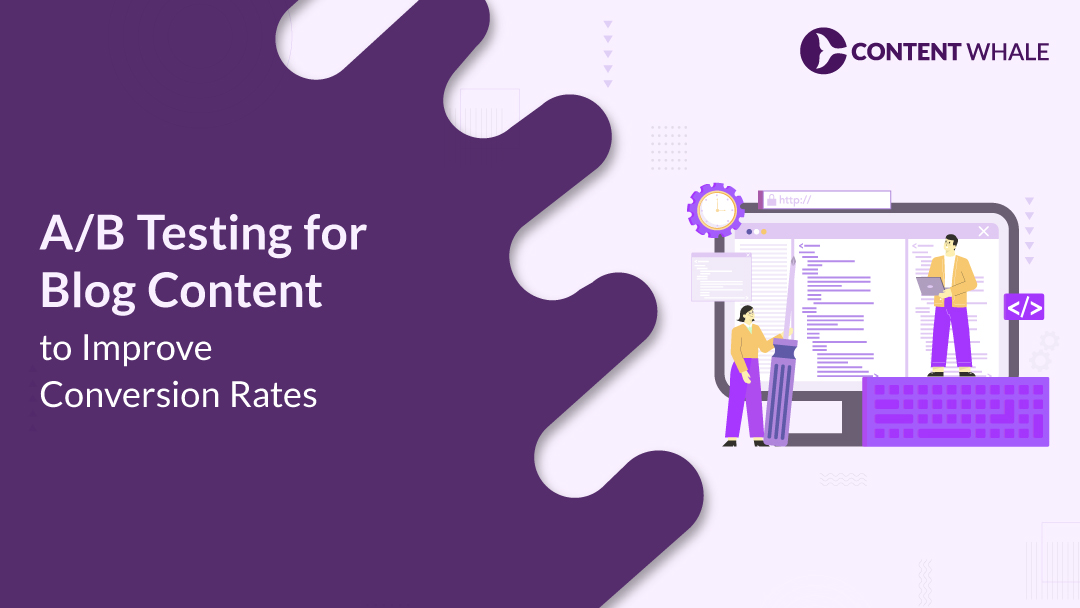A/B testing for blog content to improve conversion rates is a data-driven approach that allows businesses to optimize their blog content for higher conversion rates. Essentially, it involves comparing two variations of the same content to determine which version performs better in terms of key metrics like user engagement, click-through rates, and conversions.
The importance of A/B testing in content optimization cannot be overstated. By testing different elements such as headlines, call-to-action (CTA) buttons, and content length, you can gain valuable insights into user behavior and preferences. This allows you to make informed decisions, continuously improve content performance, and ultimately, increase conversion rates.
The flexibility of A/B testing makes it an essential tool for content creators and marketers alike. It empowers you to fine-tune your blog optimization efforts, resulting in more targeted and effective content.
1. What is A/B Testing in Content Marketing?
A/B testing, often referred to as split testing, is a method where two versions of content—version A and version B—are tested against each other to see which one drives better results. This approach allows marketers to evaluate how small changes impact user behavior and conversion optimization.
Here’s how it works:
- Create Variations: Start by creating two versions of the same content. For example, you might alter the headline or change the call-to-action (CTA) button’s color or text.
- Split Audience: The audience is split into two segments. Each group is shown one of the two variations. By analyzing the reactions of each group, it’s possible to see which version performs better.
- Track Metrics: Common metrics to track include click-through rates, bounce rates, and overall user engagement. These data points help determine which version resonates more with the audience.
Benefits of A/B testing include:
- A clear, data-driven understanding of what improves content performance.
- The ability to tweak content continuously for better conversion rate improvement.
2. Key Elements to Test in Blog Content
When conducting A/B testing for your blog, it’s essential to focus on testing key content elements that directly affect user engagement and conversion rates. Below are the most impactful components to experiment with:
- Headlines: The headline is the first thing readers notice. A compelling headline can significantly increase click-through rates. Try testing variations that include numbers, questions, or emotional triggers to see which version encourages more clicks.
- Call-to-Action (CTA): The CTA is a critical element that guides users towards conversions. Experiment with different CTA placements, colors, and wordings. Small tweaks, such as changing “Buy Now” to “Get Started,” can make a big difference.
- Content Length and Structure: Does your audience prefer shorter, bite-sized information or long, detailed articles? Testing the optimal content length and how the information is structured (e.g., bullet points vs. paragraphs) can help improve user engagement.
- Visuals and Images: Images have a powerful impact on user behavior. Test different types of visuals—such as infographics, illustrations, or photos—to see which ones hold the reader’s attention and contribute to higher conversion rate improvement.
| # | Element | What to Test |
| 1 | Headlines | Experiment with different headlines using numbers, emotional triggers, or questions to improve click-through rates (CTR). Test attention-grabbing vs. informative headlines. |
| 2 | Call-to-Action (CTA) | Test placement, wording, colors, and size of CTA buttons. Small tweaks like changing “Sign Up” to “Get Started” can significantly impact conversion rates. |
| 3 | Content Length | Compare short-form vs. long-form content to determine which keeps readers more engaged and reduces bounce rate. Test different post structures (listicles, narratives, etc.). |
| 4 | Images/Visuals | Experiment with different types of visuals (infographics vs. photos) to see how they affect user engagement and time on page. Avoid irrelevant or stock images. |
| 5 | Content Layout | Test different layouts (e.g., bullet points vs. paragraphs) to see which enhances readability and increases scroll depth or interaction with the page. |
| 6 | CTA Placement | Test different CTA placements within the content (e.g., sidebar vs. inline). Effective placement can lead to higher conversion optimization. |
| 7 | Visual Media (Videos) | Test whether embedding videos increases time on page and overall interaction. Videos often lead to better engagement but may affect load time, so testing is crucial. |
3. Setting Up an Effective A/B Test for Blogs
To get the most out of A/B testing, it’s important to set up your tests correctly. Here’s a step-by-step guide:
- Choose the Right Tools: Popular tools like Google Optimize, Optimizely, and VWO allow you to run tests easily. These platforms help you split your audience, create variations, and track performance metrics like conversion rates and bounce rates.
- Set Clear Metrics: Define what success looks like. Are you aiming to reduce bounce rates, increase click-throughs, or boost conversions? Each test should focus on a single metric to avoid confusion and gain clearer insights.
- Formulate a Hypothesis: Start with a clear goal. For example, “Changing the CTA color from blue to green will increase conversions by 10%.” A well-structured hypothesis will guide your experiment effectively.
- Run the Test for a Significant Period: A successful test requires sufficient data. Ensure your test runs long enough to reach statistical significance, which depends on your site’s traffic and the difference between variations.
- Track User Behavior: Monitor your test in real-time and track important metrics like time on page, click-through rates, and user engagement to measure success.
4. Interpreting A/B Test Results and Implementing Changes
Once your A/B test concludes, the most crucial step is analyzing the results to understand user behavior and make informed decisions. Here’s how to interpret the data effectively:
- Analyze Key Metrics: Focus on the key performance indicators (KPIs) you set at the beginning. Metrics such as click-through rates (CTR), bounce rates, and conversion rates are essential to determining which version performed better.
- Identify Winning Variations: A winning variation is typically the one with higher conversions or lower bounce rates. However, ensure that the difference between the two versions is statistically significant to avoid false positives.
- Data-Driven Decisions: Once you’ve identified the successful variation, apply the learnings to optimize your content. For instance, if a headline generated more clicks, use similar headline structures in future content.
- Continuous Optimization: Testing should be an ongoing process. Implement the winning changes but continue to run tests periodically to adapt to changing user preferences and trends.
5. Common Mistakes to Avoid in A/B Testing
While A/B testing is an effective tool, some common mistakes can lead to inaccurate results. Here’s what to avoid:
- Testing Too Many Variables: Stick to testing one element at a time, like the CTA or headline. Testing multiple variables simultaneously can cloud the results, making it hard to determine which change led to the outcome.
- Stopping Tests Too Early: Running a test for an insufficient period can result in unreliable data. Ensure that the test has enough time to gather a significant amount of user interactions to produce meaningful results.
- Ignoring External Factors: Seasonal trends, traffic sources, and user behavior shifts can all influence test results. Consider these variables when interpreting your data to ensure accurate conclusions.
- Inconsistent Sample Sizes: Both versions must be shown to equally sized audiences to provide a fair comparison. Uneven sample sizes can skew the data.
| # | Mistake | Description | Solution |
| 1 | Testing Too Many Variables at Once | Testing multiple elements (e.g., CTA, layout, colors) together makes it unclear what affected the result. | Test one element at a time for clear insights. |
| 2 | Stopping the Test Too Early | Ending a test before reaching statistical significance leads to inconclusive results. | Let the test run long enough to gather sufficient data before drawing conclusions. |
| 3 | Not Reaching Statistical Significance | Relying on a small sample size can cause false positives or negatives. | Ensure your test reaches the required sample size to achieve statistical significance. |
| 4 | Neglecting Audience Segmentation | Treating all users the same ignores variations in user behavior across different segments. | Segment your audience based on behavior, demographics, or other relevant factors. |
| 5 | Ignoring External Factors | Seasonal trends or marketing campaigns can skew test results. | Consider and account for external influences during analysis. |
| 6 | Using Incorrect Metrics | Focusing only on metrics like click-through rates while ignoring conversion rates or bounce rates. | Align metrics with business goals to get a comprehensive view of performance. |
| 7 | Overlooking Mobile Users | Failing to optimize A/B tests for mobile devices can result in poor performance insights. | Always test how changes affect both desktop and mobile experiences. |
| 8 | Not Documenting Tests Properly | Lack of documentation can make it hard to replicate successful tests or learn from mistakes. | Document every aspect of the test, including variables, hypotheses, and results. |
6. A/B Testing Success Stories: Examples of Blog Optimization
Seeing real-world success stories can offer valuable insights into how A/B testing can enhance blog optimization and drive higher conversion rates. Here are a few noteworthy examples:
- Headline Testing Success: A popular marketing blog increased its click-through rates (CTR) by 30% simply by experimenting with different headline formats. By testing numbers vs. questions and emotional triggers vs. straightforward headlines, the winning variation consistently drove more traffic.
- CTA Placement and Design: A tech blog found that by changing the call-to-action (CTA) from the sidebar to within the main body of the post, conversions increased by 25%. They also tested different button colors and text, with “Get Started” outperforming “Sign Up” in terms of engagement.
- Optimizing Content Length: Another successful A/B test involved testing the length of blog posts. Shorter posts were generating higher bounce rates, while long-form content improved user engagement and increased time spent on the page. Testing content length helped fine-tune the ideal post length for their audience, boosting overall conversions.
Conclusion
A/B testing is a valuable tool for content marketers looking to optimize their blog content for higher conversion rates. From testing headlines to refining CTAs and adjusting content length, this method provides actionable insights into user preferences. By continuously analyzing the results and making data-driven decisions, you can refine your content to better engage your audience and achieve your business goals.
As you implement A/B testing in your content strategy, remember that optimization is an ongoing process. The more you test and refine, the better your blog will perform in terms of user engagement and conversion optimization.
At Content Whale, we specialize in leveraging A/B testing to optimize your blog content for improved conversion rates. Our data-driven strategies ensure that every element, from headlines to CTAs, is fine-tuned to boost user engagement. We help businesses implement successful blog optimization techniques to drive measurable results.
Let us help you unlock the potential of your blog content with effective A/B testing strategies. Contact us today for personalized solutions that fit your business needs!
FAQs
1. What are the most important elements to test in blog content?
The most crucial elements to test include headlines, CTA buttons, content length, and visuals. These elements directly affect user engagement and conversion rates.
2. How long should I run an A/B test to gather accurate results?
The test should run for a minimum of 1 to 2 weeks, depending on your site’s traffic. Ensure enough data is collected to achieve statistical significance.
3. What tools can I use for A/B testing blog content?
Popular tools include Google Optimize, Optimizely, VWO, and Crazy Egg. These tools allow you to easily split test different elements of your content.
4. How does A/B testing help improve conversion rates?
By comparing two versions of content and analyzing user behavior, A/B testing identifies which version performs better. This helps refine content to meet user preferences, leading to better conversion optimization.
5. What are common mistakes to avoid during A/B testing?
Avoid testing too many variables at once, stopping tests too early, and overlooking external factors like traffic sources or seasonality. Ensure your tests run for a significant time to gather accurate data.





